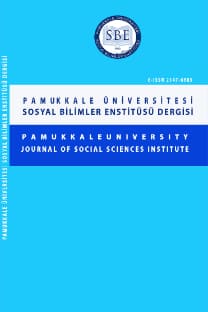WILDE' TIMES: A MARXIST READING OF OSCAR WILDE'S THE HAPPY PRINCE
ZOR ZAMANLAR: OSCAR WILDE IN MUTLU PRENS ADLI MASALINA MARXİST BİR BAKIŞ
___
- Barry, Peter. (2009). Beginning Theory. 3rd ed. Manchester UP.
- Ellis, Havelock. (1918). A Note on Oscar Wilde, The Lotus Magazine, Vol.9, No.4, Jan.
- Jones, Justin T. (2011). Unmaking Progress: Individual and Social Teleology in Victorian Childrens Fiction, Diss. North Texas UP, May.
- Lesjak, Carolyn. (2000). Utopia, Use, and the Everyday: Oscar Wilde and a New Economy of Pleasure, ELH, Vol. 67, No. 1, (Spring). published by The Johns Hopkins UP.
- Kohl, Norbert. (1980). Oscar Wilde: Das Literarische Werk Zwischen Provokation und Anpassung, Heidelberg: Carl Winter Universitätsverlag.
- Marx, Karl. (1906). Capital III . New York: Charles H. Kerr & Company.
- ---.(2000). Das Kapital: A
- Critique of Political Economy, Vol 1, Washington: Gateway Editions.
- Raby, Peter. (1988). Oscar Wilde, Cambridge: Cambridge UP.
- Smith, Philip E. (2010). Approaches to Teaching the Works of Oscar Wilde, Review by Colin Carman. Rocky Mountain Review, Vol. 64. No. 1, (Spring).
- Tyson, Lois. (2006). Critical Theory Today, 2nd Edition. New York: Routledge.
- Waldrep, Shelton. (1996) The Aesthetic Realism of Oscar Wildes Dorian Gray, Studies in the Literary Imagination, 29.1, Spring, Georgia State University.
- Wilde, Oscar. (1987). The Complete Works of Oscar Wilde, Leicester: Gallery Press.
- ---.(1909). The Happy Prince, The Happy Prince and Other Fairy Tales, New York: Brentanos.
- ---. (2001). The Soul of Man under Socialism and Selected Critical Prose, Penguin Books.
- ---.(1909). The Young King, The Happy Prince and Other Fairy Tales. New York: Brentanos.
- Wood, Naomi. (2002). Creating the Sensual Child: Paterian Aesthetics, Pederasty, and Oscar Wildes Fairy Tales, Marvels and Tales, 16.2.
- ISSN: 1308-2922
- Yayın Aralığı: 6
- Başlangıç: 2008
- Yayıncı: Pamukkale Üniversitesi
OSMANLI DEVLETİ'NDE MİLLİ KİMLİK İNŞASINDA OKUL
X. -XVII. YÜZYILLARDA YAKIN VE ORTA DOĞU'DA BİLİMLERİN TASNİFİ TARİHİ
KARL POPPER'IN YÖNTEMİNDE HİPOTETİK-DEDÜKTİF FORMUN BİLİMSEL İNŞASI
A SHAWL TO REMEMBER: CYNTHIA OZICK'S NARRATIVE AGAINST FOR GETTING IN THE SHA WL
WILDE' TIMES: A MARXIST READING OF OSCAR WILDE'S THE HAPPY PRINCE
INTERNATIONAL HUMAN RESOURCE MANAGEMENT AND NATIONAL CULTURAL CHALLENGES
